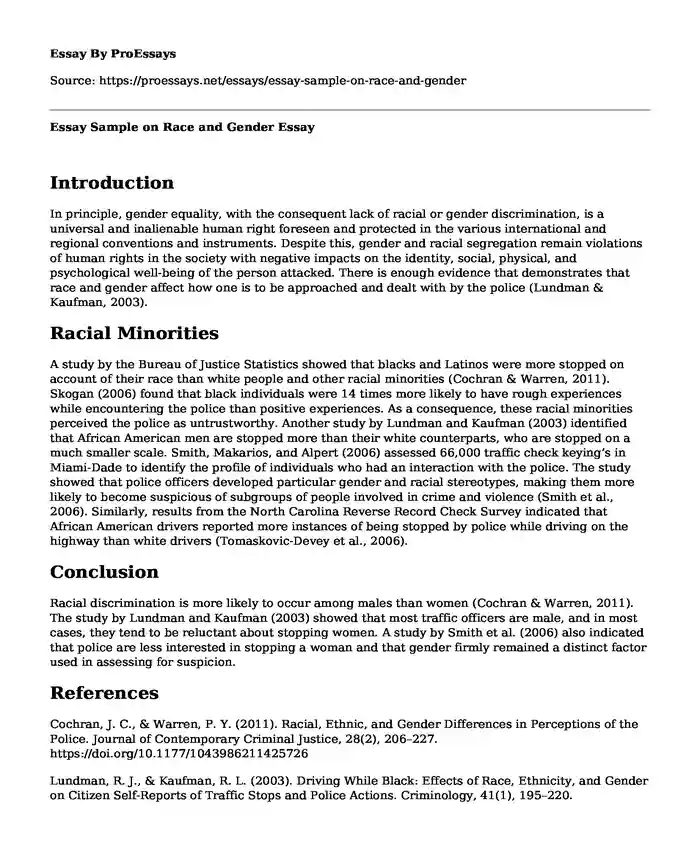Introduction
In principle, gender equality, with the consequent lack of racial or gender discrimination, is a universal and inalienable human right foreseen and protected in the various international and regional conventions and instruments. Despite this, gender and racial segregation remain violations of human rights in the society with negative impacts on the identity, social, physical, and psychological well-being of the person attacked. There is enough evidence that demonstrates that race and gender affect how one is to be approached and dealt with by the police (Lundman & Kaufman, 2003).
Racial Minorities
A study by the Bureau of Justice Statistics showed that blacks and Latinos were more stopped on account of their race than white people and other racial minorities (Cochran & Warren, 2011). Skogan (2006) found that black individuals were 14 times more likely to have rough experiences while encountering the police than positive experiences. As a consequence, these racial minorities perceived the police as untrustworthy. Another study by Lundman and Kaufman (2003) identified that African American men are stopped more than their white counterparts, who are stopped on a much smaller scale. Smith, Makarios, and Alpert (2006) assessed 66,000 traffic check keying’s in Miami-Dade to identify the profile of individuals who had an interaction with the police. The study showed that police officers developed particular gender and racial stereotypes, making them more likely to become suspicious of subgroups of people involved in crime and violence (Smith et al., 2006). Similarly, results from the North Carolina Reverse Record Check Survey indicated that African American drivers reported more instances of being stopped by police while driving on the highway than white drivers (Tomaskovic-Devey et al., 2006).
Conclusion
Racial discrimination is more likely to occur among males than women (Cochran & Warren, 2011). The study by Lundman and Kaufman (2003) showed that most traffic officers are male, and in most cases, they tend to be reluctant about stopping women. A study by Smith et al. (2006) also indicated that police are less interested in stopping a woman and that gender firmly remained a distinct factor used in assessing for suspicion.
References
Cochran, J. C., & Warren, P. Y. (2011). Racial, Ethnic, and Gender Differences in Perceptions of the Police. Journal of Contemporary Criminal Justice, 28(2), 206–227.
https://doi.org/10.1177/1043986211425726
Lundman, R. J., & Kaufman, R. L. (2003). Driving While Black: Effects of Race, Ethnicity, and Gender on Citizen Self-Reports of Traffic Stops and Police Actions. Criminology, 41(1), 195–220.
https://doi.org/10.1111/j.1745-9125.2003.tb00986.x
Skogan, W. G. (2006). Asymmetry in the Impact of Encounters with Police. Policing and Society, 16(2), 99–126. https://doi.org/10.1080/10439460600662098
Smith, M. R., Makarios, M., & Alpert, G. P. (2006). Differential Suspicion: Theory Specification and Gender Effects in the Traffic Stop Context. Justice Quarterly, 23(2), 271–295.
https://doi.org/10.1080/07418820600688883
Tomaskovic-Devey, D., Wright, C. P., Czaja, R., & Miller, K. (2006). Self-reports of Police Speeding Stops by Race: Results from the North Carolina Reverse Record Check Survey. Journal of Quantitative Criminology, 22(4), 279–297. https://doi.org/10.1007/s10940-006-9012-0.
Cite this page
Essay Sample on Race and Gender . (2024, Jan 11). Retrieved from https://proessays.net/essays/essay-sample-on-race-and-gender
If you are the original author of this essay and no longer wish to have it published on the ProEssays website, please click below to request its removal:
- Paper Example on Cyber Bullying as Ethical Issue
- Importance of Accountability Essay
- Ways to Reduce the Risk That Youths in Foster Care Will Become Homeless After Aging Out - Research Paper
- Essay on Social Class and Parenting Practices
- Essay Example on Peacekeeping: A Key Conflict Management Tool for Global Stability
- Exposure to TV Portraying Interpersonal Conflicts and Controlling in Romantic Relationships: Essay Sample
- Free Essay Sample on Gender Equality: Balancing Femininity & Masculinity







